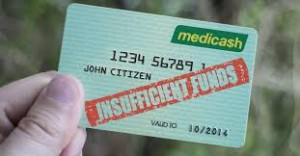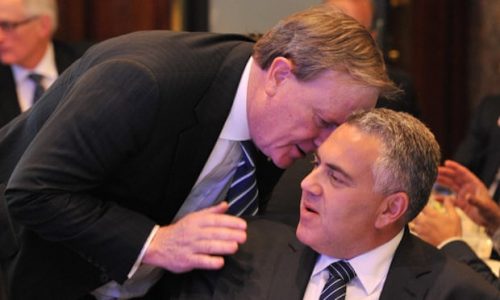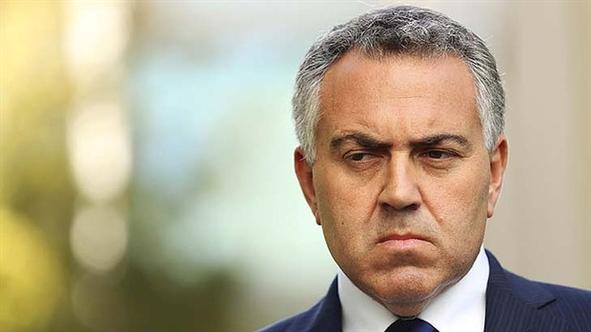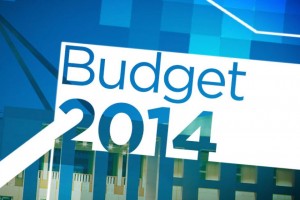With the government facing a hostile Senate passing all of its Budget measures, John Massam reflects on how wicked and unnecessary this Hockey Budget actually is. And the contrived ‘budget emergency’ – popularly spouted by our Treasurer – also appears to have been adopted by a State counterpart.
The Hockey Budget of May 13 seems to be the most wicked since the budgets of the Great Depression of 1929-41. Those cheese-paring budgets and large wage cuts left Australia unprepared for the attempted invasion during the Second World War. Global austerity had ruined the lives and psyches of millions throughout the world, and had triggered Fascist and Communist dictatorships. However, when the Second World War broke out, after about a year, rivers of credit then appeared out of thin air, and after the war the cash kept flowing to re-absorb the armed forces and the male workers in the defence industries.
There is a A$97,570,000,000 Australian “Future Fund” earning dividends. For Prime Minister Tony Abbott, Treasurer Joe Hockey, and the Finance Minister, the future HAS COME – pay off debts.
It is alarming to learn that the Australian national debt is $339 TRILLION (that is, $339 thousand million) and rising; the annual interest bill is $11 trillion, according to the Debt Clock. (Each citizen’s share is A$14,450).
Soon after being elected, in October 2013 one of the new Abbott Government’s silliest actions was to give $8.8 billion (that is, $8,800,000,000) to the Reserve Bank of Australia, which had not requested any money. (See also The West Australian, page 15, Tue May 20, 2014).
That RBA $8.8 billion, plus the $97.57 billion in the Future Fund, ought to be immediately used to pay off some of the $339 trillion debt, thus saving trillions of dollars now and into the future.
WESTERN AUSTRALIA’S CONTRIVED CRISIS
Just like the Federal financial situation, the supposed crisis in Western Australia’s State finances had also been carefully contrived, by taking on unnecessary public works like digging up the Perth Esplanade, and removing the school-children’s tiles at the Bell Tower. Mr Colin Barnett’s Liberal-National government plans to build ovals for million-dollar-a-year footballers. Another waste was spending millions removing the Perth tunnel’s emergency lanes, just as a coroner in another state was recommending that tunnel emergency lanes be introduced there as a safety measure. The ministers sold land worth $90 million at Burswood for $60 million.
To catch great white sharks, blamed for killing several people, the Coalition spent millions of dollars on drum-lines, but though other sharks suffered, no great whites were caught.
Although the Barnett-Buswell government broke election promises such as not building rail to Ellenbrook, the W.A. debt rose from $4,000,000,000 in 2008, to $20 billion by Dec. 2013 (ST, 22 Dec 2013, p 57).
W.A.’s credit-rating fall from AAA to AA should be given a quadruple A award for deception.
The Liberal-National W.A. Government, while building a kind of palace for ministerial offices, even abolished the Government Astronomer. One wonders if he and his colleagues can be “retrained” to obtain other careers! Coffee-making baristas, lens grinders, or government “spin doctors”, perhaps?
While the Liberals-Nationals are planning to change the laws to introduce mandatory minimum crime sentences, there is a judge short on the W.A. Supreme Court, prisons are over-full, and a whole police training intake would have been cancelled, except for a public outcry. The compulsory amalgamation of local government councils will be forced through, no matter what the cost, defying the spirit of the W.A. Act.
FEDERAL $7 MEDICAL LEVY FOR SENIORS, SICK, AND CHILDREN
To return to the federal scene, do the Federal Liberals’ partners, the National Party (formerly the Country Party), really intend to saddle the old, the sick, and children with a $7 medical levy? Do they join in the pretence that some of the money will go into medical research, yet the Federal Government wants to take millions of dollars away from Australian research bodies like the Commonwealth Scientific and Industrial Research Organisation (CSIRO)?

Image by getup.org.au
Are our country cousins supporting the trickery of acting as if the medical researchers in our universities and teaching hospitals are not efficient? The W.A. burns cures discoveries alone prove their excellence. Yet universities are to have cuts. Are our Nobel Prize winners and their laboratories to be “privatised”? When everything has been sold, how will governments, State and Fedeal, “balance” their budgets then?
Have voters for the National Party already forgotten that the Liberal-National government was willing to allow Shepparton’s cannery to close in Victoria, thus threatening to ruin most of the small fruit-growers in the Goulburn-Murray Valley region? Have Liberal supporters forgotten that many small engineering enterprises will be ruined as the three car-manufacturers wind down? These metal-fabrication experts could be “retrained”, perhaps, to be prospectors?
Don’t the Coalition know that many overseas governments underwrite and subsidise industry and agriculture?
WASTE, SILLINESS, SELL-OUTS
Without consultation, Abbott’s boys (only one female minister) have ordered a larger number of warplanes than Labor did; these planes have no limit to their final cost, just like the Liberal-National coalition purchase of the F111s decades ago.
Another silliness is to plan to privatise the Royal Australian Mint, although for thousands of years governments have jealously guarded the right to mint coins, and in later centuries they forcibly took over banknote issuing from the private banks. Will the sell-outs of public assets be accompanied by the corruption that was recently uncovered in New South Wales, causing a Liberal Premier to resign that day?
UNIVERSAL LAND TAX – OTHER TAXES MINIMISED
As was reported in recent months, David Airey, a leading Perth real estate agent, suggested a no-exception land tax (I suggest about 5 per cent for a start, rising to no more than 10 per cent in future) on the land’s value (not the buildings, etc). A side benefit would be that this would slow down land speculation and the withholding of land. New home buyers might then have a chance of taking on affordable mortgages for land and houses.
Calculations are that this could pay all the government’s expenses. As this huge revenue came in, a priority must be to reduce and/or abolish the enterprise-stifling taxes like payroll tax, stamp duty, and the goods and services tax (GST). If the land-site revenue covers the running costs, income tax and company tax could be immensely reduced, moving towards abolition, as debt was gradually eliminated. In the meantime, negative gearing plus company tax evasion and avoidance could be stopped by a few simple laws.
A universal land tax idea, backed by some academics, was recommended in the Henry Report (Australia’s Future Tax System Review) around 2010. However, widening land tax was so unpalatable to the Big End of Town that the recommendation was dropped at once by the politicians.
An alternative is that Federal and State governments introduce the Tobin Tax – a small levy on every financial transaction. A 0.1 per cent Tobin Tax would collect huge sums from parasites such as those who use sophisticated computer programmes tied to the stock exchange to manipulate share prices by speculative buying and selling of shares, bonds, etc, in microseconds, thus cheating the ordinary Mum and Dad investors. It would raise $135 trillion (about a third of the national debt) at the start, but might decline markedly later.
If that tax is not acceptable, there are billions of dollars worth of minerals being exported, so a reasonable royalty per tonne would bring in millions or billions. Norway and other countries levy a very large percentage. Don’t charge on profits, because the multinational corporations and some big Australian investors are experts at exporting their profits overseas to places with little or no income tax.
It would be too much to expect that the politicians and their advisers would study how money comes into being, and so adopt credit policies, instead of debt policies.
INTERNATIONAL BANKERS, BUREAUCRATS
This is a nasty bankers’ budget. Just read the words of Treasurer Joe Hockey, in his speech “The end of the age of entitlement” on April 17, 2012, to the Institute of Economic Affairs, in London, when he said that bankers “have a more active role to play in policing public policy and ensuring that countries do not exceed their capacity to service and repay debt.
“This is playing out most dramatically in Europe where the European Commission and the European Central Bank are either directly or indirectly heavily influencing public policy in Greece, Italy, Spain and Portugal, to name a few.” (page 14).
In plain speech, he was saying that the EU bureaucrats and the ECB bankers were calling the tune for an austerity campaign. Mr Hockey seems to be in thrall to what he called that mysterious and amorphous group defined as “bondholders” (page 4 of the same speech).
So, Mr Hockey in 2012 thought that it was good for Australia to accept the wrong-headed policies adopted under duress by those countries, even though they have led to higher unemployment plus hardship to small business in those lands, and have driven many people to bankruptcy, crime or suicide.
Wild riots and possible takeovers by dictatorships are quite possible in countries which take the International Monetary Fund’s poisonous medicines.
The brave little country of Iceland refused to take the advice of international funds and bankers, and took firm action. Icelanders have been saved from the artificial depression planned for them.
A most amazing fact is that when Mr Hockey took over as Treasurer after the September 2013 election win, it was brought to his notice that the Federal Parliament had set a debt ceiling of $300 billion, and this had nearly been reached.
He promptly said that Australia must not have a stoppage of government action like the United States had suffered twice in recent years, and the debt ceiling should be doubled. The high debt level was caused by the Labor Government, he said. Not long after he said that the debt ceiling should be tripled.
Another version in a report of December 5, 2013, said the Liberals wanted a $500 billion limit, but later did a deal with the Greens in the Senate to set it at $400 billion.
Before the 2013 election the Liberals had said they would reduce debt. Voters, another promise broken!
WORK TO 70, PREVENT YOUNGSTERS WORKING
The minor parties have a duty to stop the Government from expecting the old to work until 70, thus preventing the younger generation from starting careers, while ordering the under-25s who can’t get jobs to starve for six months. At present about 25 per cent of the young are unemployed, and this budget seems certain to increase the number of jobless.
To dismiss 16,000 public servants would turn them out onto the streets, and double the workload of those not dismissed. Perhaps they could “retrain” to be politicians?
These cruel Canberra federal policies would increase the crime rate and the demand for more prisons – and that would cost money (a State responsibility, no doubt!), and lead to more deaths, nervous breakdowns, and suicides. Will overworked police be less inclined than at present to investigate and prevent petty offences?
FOR 39 YEARS STATE LIBERALS WERE NOT RESPONSIBLE MANAGERS
While in Opposition in 1975 Liberal leader Malcolm Fraser (later that year elected as Prime Minister) said that “those levels of government responsible for spending money should also be responsible for raising the taxes.” (Malcolm Fraser; The Political Memoirs, 2010, M.Fraser and M.Simons, Melbourne University Publishing, Carlton, Victoria, page 278).
So, if this was principled “federalism policy” 39 years ago, why didn’t the Liberal-National Parties, which were at times running the States and the Northern Territory, keep out of debt by levying universal land tax, and/or revert to collecting income/company tax? Or is it easier to blame the Federal Government when States are reducing the police forces, cutting the number of judges, and under-staffing hospitals and schools?
The Liberal Party has a cheek asking the disadvantaged to stand on their own two feet; this was exposed as hypocrisy in the news-item “Pay your way, backer tells Libs,” The West Australian, page 3, Feb 7, 2014. The party’s WA branch has been operating rent-free in Menzies House, Level 4, 640 Murray St, West Perth, for decades. The landlord is now giving them their own medicine.
In the minds of some Australians, perhaps the only Abbott policy that is working is Operation Sovereign Borders, which at present has stopped the ‘illegal’ undocumented clients of the people-smugglers coming in as asylum-seekers. But even those effective government instrumentalities are to be chopped up and the command structure amalgamated, presumably at great cost. Who knows if the new management will be asked to sack people after another demand for an “efficiency dividend”?
A real cost-saver would be to cut out “457 visa”, “student visa”, and “working visa” visitors who in a few year become Australian electors, at least until unemployment goes down to 1 or 2 per cent, not long-term 5 per cent.
Anyone who doubts my statements about the way the Money Lords over-awe nations’ governments ought to read Confessions of an Economic Hit Man, 2005, by John Perkins, Plume Publishing.
For an Australian perspective on deceit by the Big End of Town and the banksters, read Bankers and Bastards, 1992, by Paul McLean and James Renton, Hudson Publishing, Victoria, Australia.
Another eye-opener is The Secret Life of Real Estate and Banking, 2009, by Phillip J. Anderson.
My final word is that the Coalition is breaking nearly all of its pre-election promises, including “There will be no surprises,” just like the Labor Rudd/Gillard/Rudd government did. The latter tried to stave off the unnecessary Global Financial Crisis with its spending on Roads to Recovery (good) and Ceiling Batts (no OHS there! Dr Troy Delbridge was dismissed). Fortunately, the Senate and the States, if they stand firm, might be able to curb the Abbott-Hockey irrational and irresponsible plans that are likely to lead to a trade depression, and a down-spiral of budget deficits.
















